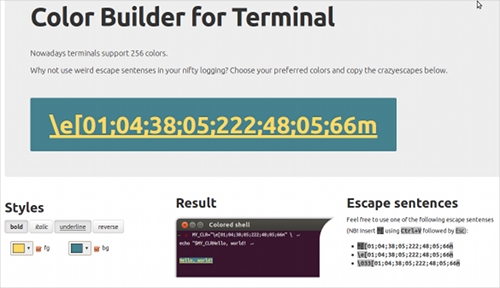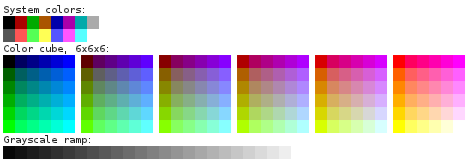
I’m currently reinventing a wheel, driving a long debug output to stdout. I finally came to conclusion that the only way not to get my eyes broken leads to colorizing all the output. Modern terminals like xterm are able to show 256 colors, they do even like it. But those mastodons who are still giving their VT100 a dust, have curly escape-sequences chosen to show a rainbow up. I revere a backward compatibility; I even have a latent tendency to cryptographic empiricism… You know, it took me a couple of hours to sort the stuff out. Internet gave not a rich detailed explanation, as well.
Nowadays a text in the X-terminal may appear in an ornate way. That’s why I came with jotting down a web-service. It’s likely a WYSIWYG for escape-sequence generation. One choses colors, font styles etc and finally gets a bundle of flourishes.
Colors in xterm
For a terminal to realize that it can show 256 colors, we should aknowledge it about:
case "$TERM" in
'xterm') TERM=xterm-256color;;
'screen') TERM=screen-256color;;
'Eterm') TERM=Eterm-256color;;
esac
The color itself is encoded in quite breathtaking manner. Escape-sequence is starting with the traditional \e[ and ending with m. It consists of flags, the color of the background and the text color. Flags for bold, italic, underline and inverse (fg ⇐ ⇒ bg) are 01, 03, 04 and 07 respectively (there is a flag for the flashing as well, but what if there are children reading this?) Flags to cancel the style are 22, 23, 24, 27. Flags can be written in simultaneous order, one after another, separated by semicolons. There must be no semicolon just before the final m.
The text color signature is 38, 05; COLOR;. The same for background color is 48, 05; COLOR;. The color here is an integer ∈ [1, 255]. The first sixteen items are well-known old-school terminal colors, the last 24 are shades of gray, and the rest… well, these are the remainder colors.
Something like that (thanks FedoraProject for the picture):

It is easy to see that the sequence \e[01;04;38;05;196;48;05;232m turns the mode of a bold underlined red text on a black background. Haha.
###How to get a color, huh?
It turns put that colors are encoded in the remaining 256 - 16 - 24 = 216 choices using a simple and straightforward algorithm. A range of tones is calibrated against division modulo 6. That number is treated as RGB-constituent in 6-based notation with “zero in sixteen”. For orange (#ff9900) it gives 16 + 5 * 6² + 3 * 6 + 0 = 214). There are exceptions; they will be there any time. Those “standard” old-school colors and grayscale. Yeah.
Who the hell does need that?
Well, first of all, I was curious. Secondly, three hours are three hours. Furthermore I have now my logfile so weird-colored that it’s became totally ununderstandable. Plus PS1 is surely re-written from scratch.
In general, if you need an escape-sequence for some color—here’s a WYSIWYG. If somebody likes to examine spaghetti-like write-only javascript code, welcome @github.